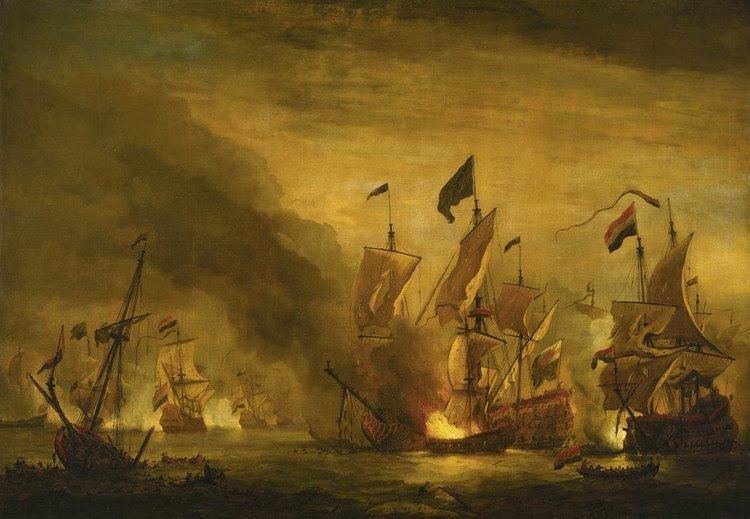Rank Rear Admiral | Died 1688, West Indies, Cuba Name John Narborough | |
 | ||
Buried Knowlton, Kent (51°14′1″N 1°16′1″E / 51.23361°N 1.26694°E / 51.23361; 1.26694Coordinates: 51°14′1″N 1°16′1″E / 51.23361°N 1.26694°E / 51.23361; 1.26694) Battles/wars Battle of Sole BayActions against the Barbary pirates Other work Commissioner of the Navy Place of burial Knowlton, Kent, United Kingdom Books An Account of Several Late Voyages and Discoveries to the South and North | ||
Battles and wars Battle of Solebay | ||
Rear-Admiral Sir John Narborough (c. 1640–1688) or Narbrough was an English naval commander of the 17th century. He served with distinction during the Anglo-Dutch Wars and against the Barbary Coast pirates.
Contents
Early life
He was descended from an old Norfolk family and married Elizabeth Hill, with whom he had two surviving sons. Her father was John Hill, a Commissioner of the Navy. After her husband's death, Lady Narborough married Admiral Sir Cloudesley Shovell.
Career
He received his commission in 1664, and in 1666 was promoted lieutenant for gallantry in the action with the Dutch fleet off the Downs in June of that year. After the peace he was chosen to conduct a voyage of exploration in the South Seas. He set sail from Deptford on 26 September 1669, and entered the Straits of Magellan in October of the following year. In 1670 he visited Port Desire in Argentina and claimed the territory for the Kingdom of Great Britain, but returned home in June 1671 without accomplishing his original purpose. A narrative of the expedition was published at London in 1694 under the title An Account of several late Voyages and Discoveries to the South and North.
During the Third Anglo-Dutch War Narborough was second captain of the Lord High Admiral's ship the HMS Prince. He conducted himself with such conspicuous valour at the Battle of Sole Bay in May 1672, following the death in action of his superior Sir John Cox, that he won special approbation, and shortly afterwards was made rear-admiral and knighted. In 1675 he was sent to suppress the Barbary piracies, and by the bold expedient of despatching gun-boats into the harbour of Tripoli at midnight and burning the ships, he induced the Dey to agree to a treaty. There is an account of the raid in the diary of the naval chaplain Henry Teonge. The Lieutenant who planned and executed the burning of the ships in the harbour was Cloudesley Shovell, who later married Narborough's widow.
Shortly after his return, Narborough undertook a similar expedition against the Algerines. In 1680 he was appointed commissioner of the Navy, an office he held until his death in 1688. During these years he was a patron of a treasure hunter from New England. Narborough invested in an expedition by William Phips to find wrecked Spanish treasure ships in the Caribbean, and worked to enlist the support of Charles II and others in the venture. Phips' first expedition, made in 1682 and funded by New England investors, was only marginally successful. His second expedition in 1683–85, was less successful, but he gained valuable leads, and Narborough was able to help him raise funds for a third expedition. Departing in September 1686, Phips located a valuable wreck in February 1687, and returned to England with treasure valued at over £200,000, which gained him approbation and a knighthood. After this success, Narborough decided to lead a follow-up expedition the following year. Returning to the wreck, the English found that it had been discovered by others. They only recovered about £10,000 of treasure before Narborough fell ill and died aboard ship in May 1688.
Narborough had bought the Knowlton Court estate near Dover from the executors of Sir Thomas Peyton and was buried in Knowlton church. His eldest son John was created a baronet in November 1688 (see Narborough Baronets), in honour of his father. Sir John died with his brother James and their stepfather Admiral Sir Cloudesley Shovell aboard HMS Association during the Scilly naval disaster of 1707. Narborough's widow is buried in St Paulinius Church, Crayford, where there is a memorial to her and her second husband. Narborough's two sons were buried in Old Town Church on St Mary's, Isles of Scilly. Knowlton Court passed to his daughter Elizabeth, who married Sir Thomas D'Aeth in about 1714.
Memorials
Knowlton church has monuments to Sir John and to the memory of his sons. The latter depicts the grounding of the Association. The island of Fernandina, the westernmost in the Galapagos archipelago, was originally named Narbrough Island in his honour, by the 17th century buccaneer William Ambrosia Cowley.
